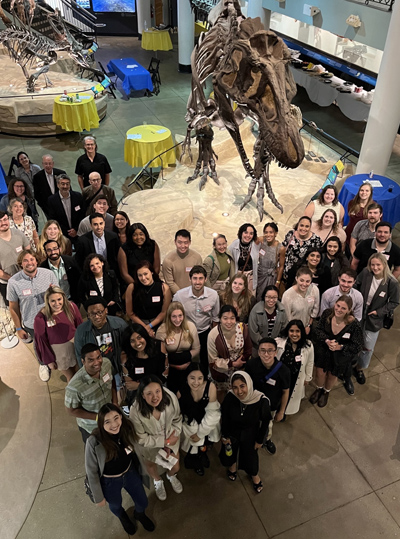
Early last November, 50 first-year medical students from both the Queen Lane and West Reading Campuses gathered at Drexel’s Academy of Natural Sciences for an evening of presentations by a science historian, ornithologist and ichthyologist.
Examining Renaissance texts in Latin, bird bones and eel specimens may seem tangential to a medical student’s typical course of study. And that’s precisely why Daniel Schidlow, MD, director of bioethics, medical humanities and professional formation at Drexel University College of Medicine’s West Reading Campus, sought to organize the event for students. Understanding the interplay between the natural and medical sciences, he argues, is integral to the development of a well-rounded physician.
“It made a lot of sense for the two institutions to partner. The event was an opportunity for students to understand the history of medicine and to connect to some of their own interests outside of the field,” he says, acknowledging the close collaboration of Scott Cooper, PhD, president and CEO of the Academy, as well as Andrea Bensusan and Laura Mullin, program coordinators at the College of Medicine. “This sort of exposure ultimately contributes to the formation of a professional — more empathic, more aware, more connected to the world at large and to one another.”
A short drive from the College of Medicine’s Queen Lane Campus, the Academy, which was founded in 1812 and forged an affiliation with Drexel in 2011, houses a world-class collection of biological specimens. The oldest natural science research institution in the Americas, it boasts over 18 million plant and animal species. Among its founders and early leaders were medical doctors.
“At the time, physicians had long pursued the natural sciences in order to understand the use of plants and other natural resources in medicine. The two fields were deeply interrelated,” explains Pedro Raposo, DPhil, executive director of library and archives at the Academy, and one of the event’s three presenters. Like Schidlow, he was eager to collaborate and share with students how the Academy’s holdings can enrich their perspective. “It’s all part of developing a more humanistically and culturally framed understanding of medicine and medical practice,” he adds.
Following a buffet dinner in Dinosaur Hall, students and a handful of College of Medicine faculty — including Steven Rosenzweig, MD, director of the Office of Community Engagement, who was also involved in organizing the event — broke into small groups and rotated through three presentations.
Gathering students around a large table, Raposo displayed two early printed books from the museum’s collection, both dating back to the mid-1500s and filled with intricate wood carvings, metal engravings and woodcut illustrations. The first text, a 4,500-page compendium of animals, was written by Swiss physician and naturalist Conrad Gessner. The second, a treatise on plant materials published by Italian physician Pietro Andrea Mattioli, was considered one of the most prominent reference works for physicians well into the 18th century.
In addition to probing the connection between the natural and medical sciences, Raposo led students in a conversation that considered the relationship between science and power, and how imperial expansion and colonialism impacted the evolution of science and the dissemination of knowledge.
“The students were very enthusiastic and showed great curiosity,” he recalls. “Precisely because we live in a digital age, the physical book acquires a new meaning and new appeal.”
Students were also treated to presentations by Luke Musher, PhD, postdoctoral scholar in ornithology, as well as Mark Sabaj, PhD, collection manager of fishes.
West Reading student Caitlyn Curley, MD ’26, was particularly taken by the vast fish specimens shared by Sabaj, and current research on the impact of microplastics found in various species. “As I make my way through my first year of medical school, I see that medicine is so much more than just the basic sciences — it intersects with all aspects of the world around us,” she says. “The event helped me to have a greater understanding of just how much we can learn about our health from studying the environment.”
The event was also a chance for students to visit just one of many local educational and research institutions at their disposal. “My personal interest was also for students to understand and realize the tremendous resources they have access to at Drexel,” Schidlow says. Raposo agrees, noting that the Academy is in part meant to act as a classroom to serve Drexel students and faculty. November’s event marked the second occasion that the College of Medicine has collaborated with an organization to widen the lens of student learning. The first, a visit to the Mütter Museum, at the College of Physicians of Philadelphia, took place in 2021. In the future, Schidlow hopes to plan an outing closer to the West Reading Campus.
This opportunity to unite the two campuses was another driving force in his effort to organize the event. “It is very important that even though the two campuses are 50 miles apart they do not see each other as different entities,” he says. “I’m prone to symbolism, but this event was an important reminder that we are one school.”